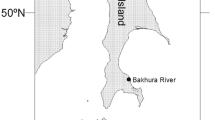Abstract
The genetic relationships among South-East Asian populations of the scad mackerels Decapterus macarellus, D. macrosoma and D. russelli (Pisces: Carangidae) were investigated. In 1995 and 1996, 216 fish were sampled in seven localities spanning the seas of Indonesia and were examined for restriction-site polymorphisms using ten restriction enzymes for the mitochondrial (mt) DNA control region, amplified by the polymerase chain-reaction. The inferred phylogeny of haplotypes led to the recognition of three distinct mitochondrial lineages or phylads consistent with the distinctions of current taxonomy. All 15 mtDNA haplotypes found in D. macarellus and all 9 haplotypes found in D. macrosoma were arranged as star-like clusters, suggesting recent evolutionary history. In contrast, the phylad formed by 6 haplotypes in D. russelli from the Sulawesi Sea exhibited diffuse topology, suggesting that ancestral lineages of this species have been retained to the present. Average nucleotide-divergence estimates between haplotypes of different phylads were between 0.042 and 0.135, suggesting ancient separation, in consistency with published allozyme data. High levels of haplotype diversity, but no geographical heterogeneity, was detected within D. macarellus from the Molucca Sea and the Banda Sea. Populations of D. macrosoma exhibited both significant differences between adjacent regions (Sunda Strait and Java Sea), and broadscale genetic homogeneity from the South China Sea to the Sulawesi Sea via the Java Sea and Makassar Strait. The geographic isolation of the D. macrosoma population sampled in the Sunda Strait suggests that this region constitute a sharp transition zone between the Indian Ocean and the Sunda Shelf. Near-monomorphism of haplotypes and low nucleotide diversity (d X) were observed in the samples of D. macrosoma from the continental shelf (haplotype-diversity estimates, h, = 0.00 to 0.25 ± 0.08 and d X = 0.000 to 0.002). This was in contrast to the comparatively high haplotype and nucleotide diversities observed in other pelagic fish species including D. macarellus (h = 0.82 ± 0.05, d X = 0.012 to 0.015) and D. russelli (h = 0.63 ± 0.12, d X = 0.016), and in the oceanic D. macrosoma population sampled in the Sunda Strait (h = 0.67 ± 0.31, d X = 0.005). We hypothesise that this may be the consequence of recent and perhaps repeated bottleneck events that have affected the D. macrosoma population sampled on the continental shelf.
Similar content being viewed by others
Author information
Authors and Affiliations
Additional information
Received: 29 September 1997 / Accepted: 3 September 1999
Rights and permissions
About this article
Cite this article
Arnaud, S., Bonhomme, F. & Borsa, P. Mitochondrial DNA analysis of the genetic relationships among populations of scad mackerel (Decapterus macarellus, D. macrosoma, and D. russelli) in South-East Asia. Marine Biology 135, 699–707 (1999). https://doi.org/10.1007/s002270050671
Issue Date:
DOI: https://doi.org/10.1007/s002270050671



